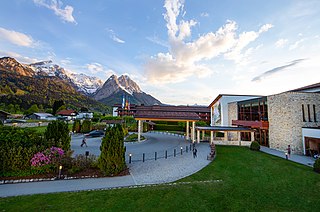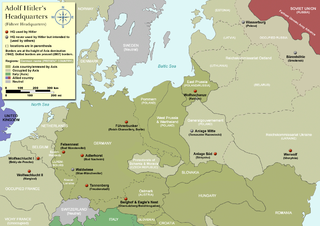
Berchtesgaden is a municipality in the district Berchtesgadener Land, Bavaria, in southeastern Germany, near the border with Austria, 30 km (19 mi) south of Salzburg and 180 km (110 mi) southeast of Munich. It lies in the Berchtesgaden Alps. South of the town, the Berchtesgaden National Park stretches along three parallel valleys.
Operation Foxley was a code name of the British Special Operations Executive (SOE) plan to assassinate Adolf Hitler in 1944. At the height of World War II, one option to swiftly end the war was killing Hitler. The SOE developed two potential assassination modules, one was to poison, and the other, shooting with a special gun. Although detailed preparations were made, no attempt was made to carry out the plan. The secret document, a 20-page dossier, was declassified in July 1998 by the British Public Record Office following the 30-year confidentiality limit.

The Berghof was Adolf Hitler's holiday home in the Obersalzberg of the Bavarian Alps near Berchtesgaden, Bavaria, Germany. Other than the Wolfsschanze, his headquarters in East Prussia for the invasion of the Soviet Union, he spent more time here than anywhere else during his time as the Führer of Nazi Germany. It was also one of the most widely known of his headquarters, which were located throughout Europe.

The Kehlsteinhaus is a Nazi-constructed building erected atop the summit of the Kehlstein, a rocky outcrop that rises above Obersalzberg near the southeast German town of Berchtesgaden. It was used exclusively by members of the Nazi Party for government and social meetings. It was visited on 14 documented instances by Adolf Hitler. Today, it is open seasonally as a restaurant, beer garden, and tourist site.

Angela Franziska Johanna Hammitzsch was the elder half-sister of Adolf Hitler. She was the mother of Geli Raubal by her first husband, Leo Raubal Sr.
Obersturmbannführer Bernhard Frank was an SS Commander of the Obersalzberg complex who arrested Hermann Göring on April 25, 1945, by order of Adolf Hitler, who had been manipulated by Reichsleiter Bormann into believing Göring was attempting to usurp the Führer's authority. Frank placed Göring under house arrest but ignored later orders to execute the Reichsmarschall.

Obersalzberg is a mountainside retreat situated above the market town of Berchtesgaden in Bavaria, Germany. Located about 120 kilometres (75 mi) south-east of Munich, close to the border with Austria, it is best known as the site of Adolf Hitler's former mountain residence, the Berghof, and of the mountaintop Kehlsteinhaus, popularly known in the English-speaking world as the "Eagle's Nest". All of the Nazi era buildings were demolished in the 1950s, but the relevant past of the area is the subject of the Dokumentationszentrum Obersalzberg museum, which opened in 1999.

Edelweiss Lodge and Resort is a U.S. Department of Defense owned recreation hotel in Garmisch-Partenkirchen, Germany. Located in the Bavarian Alps near the Austrian border, the facility opened in September 2004 at a cost of $80 million.

Eva Anna Paula Hitler was a German photographer who was the longtime companion and briefly the wife of Adolf Hitler. Braun met Hitler in Munich when she was a 17-year-old assistant and model for his personal photographer, Heinrich Hoffmann. She began seeing Hitler often about two years later.

The Führer Headquarters, abbreviated FHQ, were a number of official headquarters used by the Nazi leader Adolf Hitler and various other German commanders and officials throughout Europe during World War II. The last one used, the Führerbunker in Berlin, where Hitler committed suicide on 30 April 1945, is the most widely known headquarter. Other notable headquarters are the Wolfsschanze in East Prussia, where Claus Graf von Stauffenberg in league with other conspirators attempted to assassinate Hitler on 20 July 1944, and Hitler's private home, the Berghof, at Obersalzberg near Berchtesgaden, where he frequently met with prominent foreign and domestic officials.

The Columbus Globe for State and Industry Leaders were two purpose-made globes designed in Berlin in the 1930s, one each for Adolf Hitler and his Nazi Party.

Dokumentation Obersalzberg is a museum in the Obersalzberg resort near Berchtesgaden, providing information on the use of the mountainside retreat by Nazi leaders, especially Adolf Hitler who regularly spent time in this area beginning in 1928. The museum was opened in 1999, and by 2007 had been visited by more than one million people.

Margarete Berta "Gretl" Berlinghoff was one of the two sisters of Eva Braun. She was a member of the inner social circle of Adolf Hitler at the Berghof. Gretl became the sister-in-law of Hitler following his marriage to Eva, less than 40 hours before the couple killed themselves.

Ruins of the Reich is a documentary series that traces the rise and fall of the Third Reich through its architecture. Written and directed by film maker R. J. Adams, the film's "then and now" format focuses on the primary sites that played key roles from Hitler's rise to his final days in his Berlin bunker.

Gerhardine "Gerdy" Troost, was a German architect, interior designer, interior decorator, and the wife of Paul Ludwig Troost.

Adolf Hitler, dictator of Germany from 1933 to 1945, initiated World War II in Europe with the invasion of Poland in September 1939 and was central to the Holocaust. He was hated by his persecuted enemies and even by some of his own countrymen. Although attempts were made to assassinate him, none were successful. Hitler had numerous bodyguard units over the years which provided security.

The bombing of Obersalzberg was an air raid carried out by the Royal Air Force's Bomber Command on 25 April 1945 during the last days of World War II in Europe. The operation targeted Obersalzberg, a complex of residences and bunkers in Bavaria which had been built for Adolf Hitler and other key members of Germany's leadership. Many buildings in the complex were destroyed, though Hitler's residence and the bunker network were only slightly damaged. Two Allied bombers were shot down with the loss of four airmen, and 31 Germans were killed.

The Berchtesgaden Chancellery Branch office in Bischofswiesener district Stanggaß was built between 1937 and 1945 after plans by Alois Degano as the second seat of government of Nazi Germany for the time of Adolf Hitler's presence on nearby Obersalzberg.

The Teahouse on Mooslahnerkopf Hill was the favourite destination of Adolf Hitler when he was at the Berghof at Obersalzberg.

The Kampfhäusl was a small log cabin on the forest property of the former Gebirgskurhauses Obersalzberg in Obersalzberg. The cabin was the location where Adolf Hitler wrote the second volume of Mein Kampf.



















